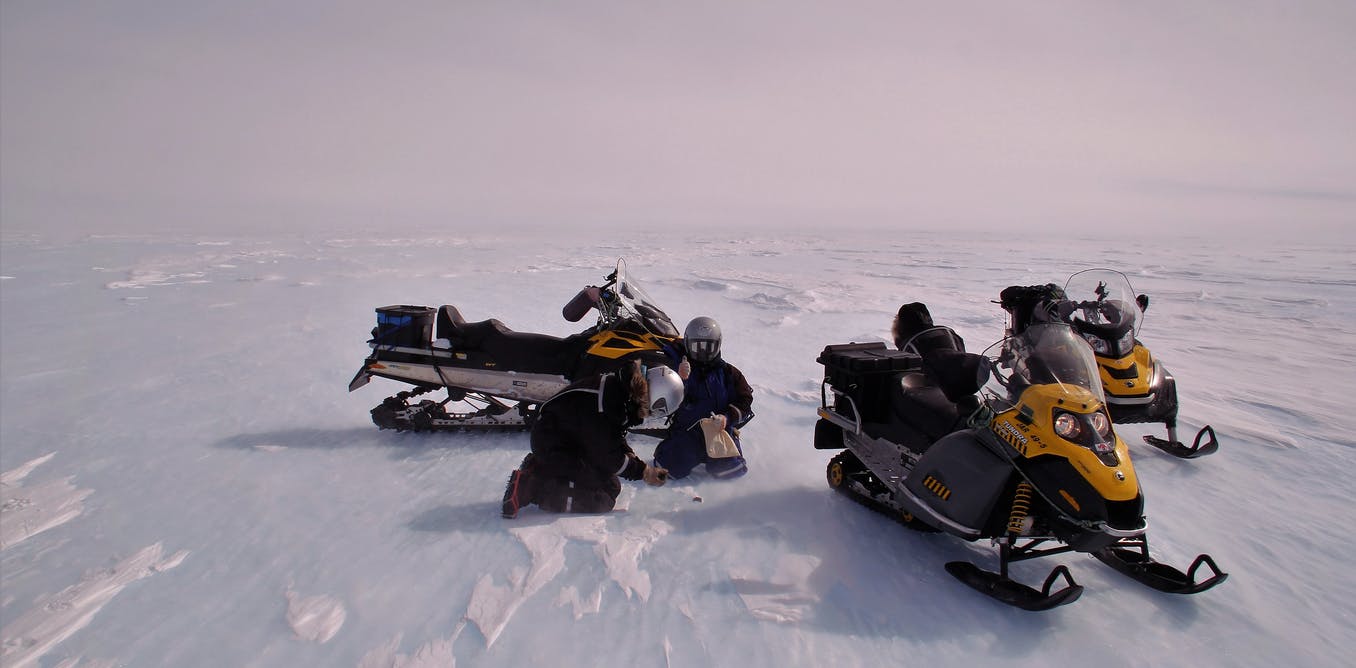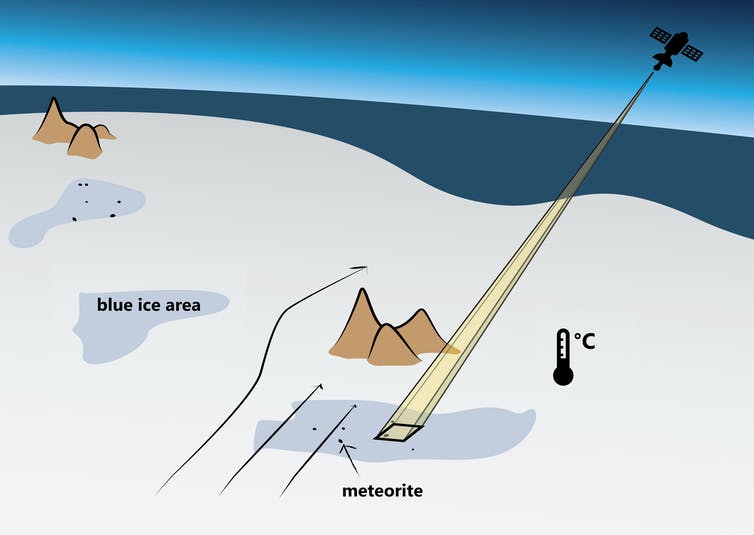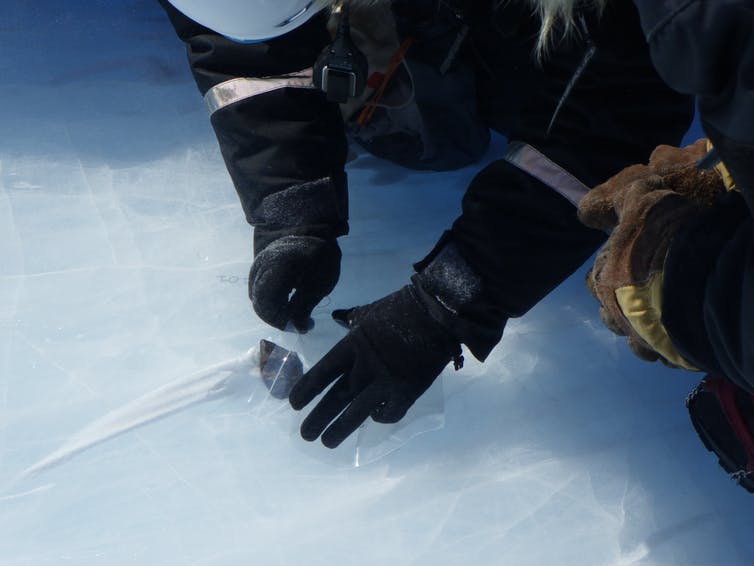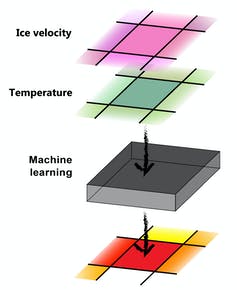Mapping out meteorites in Antarctica: scientists’ bid to uncover our solar system’s deep past

Scientists hunt for meteorites on the Nansen blue ice area in East Antartica, close to the Belgian Antarctic research station Princess Elisabeth. BELARE 2019-2020 meteorite recovery expedition on the Nansen Ice Field, Fourni par l'auteur
A Belgian-Dutch team of scientists has created the first-ever “treasure map” that shows where in Antarctica meteorites are likely to be found. Meteorites are chunks of stone-like material that can be found on the surface of the Earth after falling from space.
Unlike the earth’s rocks, meteorites have been spared from our planet’s weathering and volcanism and are therefore regarded as invaluable archives of the earliest stages of our solar system. Whereas rocks fail to tell us anything about the first half-a-billion years of our planet’s 4.55-billion-years existence, most meteorites from the asteroid belt allow us to stretch back to 4.6 billion years ago. The vast majority of recorded meteorites in Antarctica come from the asteroid belt, with about 1% hailing from the Moon and Mars.
Meteorites in Antartica
Meteorites fall regularly on the surface of the Earth: in France around 50 meteorites weighing more than 10g rain down every year. However, pinning them down is like searching a needle in a haystack, and scientists from meteorite-recovery campaigns often return empty-handed.
In contrast, it is surprisingly easy to track down meteorites in the remote South Pole. This is because of a principle known as the concentrating mechanism, whereby specific ice-flow and meteorological patterns lead meteorites to pool in rather small areas known as meteorite stranding zones.

Satellite observations on factors such as ice flow velocity or surface temperature help scientists predict which blue-ice areas contain meteorites.
Veronica Tollenaar
When meteorites fall on the Antarctic, they typically lodge themselves within the ice sheet and drift toward the oceans. This has led some to describe ice as a “natural conveyor belt” for meteorites. At times, mountains – occasionally hidden under the ice sheet – may come in their way and redirect them toward the surface of the ice sheet.
Meteorites are always found on the surface of areas where the wind has dusted off the snow, leaving a blue-tinted ice exposed. Such zones are known as blue-ice areas. Although meteorites are always recorded in such areas, not all contain them.
Once a meteorite-rich, blue-ice area has been identified, it is relatively simple to spot the darkly coloured stones against the ice’s light hues. The success of meteorite searches in Antarctica is unparalleled: over 60% of the Earth’s recovered meteorites are located in the Antarctic ice sheet. And the potential remains largely untapped: to date, only a part of all Antarctic blue-ice areas has been checked for meteorites, with varying degrees of success.
Determining where to search
To establish where to search meteorites, we firstly need to understand what differentiates a meteorite-rich blue-ice area from one without meteorites. To this end, there is a lot of data available: the location and year of discovery of meteorites are stored in a special meteoritical bulletin database. Scientists can also access field reports detailing some of the successful and unsuccessful meteorite missions that have been conducted since the discovery of the concentrating mechanism in 1969.
Until now, deciding where to search was a task conducted by a small number of experts. This means there is a huge human factor involved in meteorite recovery missions – and it is not possible to evaluate the potential of every single area in a continent that is about 25 times the size of France. To help plan what are often expensive and logistically complicated missions, our team developed a map that shows potential meteorite stranding zones.

A scientist collects a meteorite in a blue-ice area. JARE-54/BELARE 2012–2013 expedition to the Nansen blue-ice field.
From the real world to the observed world
To make a meteorite “treasure map”, we had to translate the real world into observable numbers. To this end, we applied a grid of cells measuring 450 by 450 metres over blue-ice areas and their close surroundings.
In cases where meteorites have been found within a grid cell, the grid cell is labelled as “positive”. The remaining grid cells are left unlabelled. Every cell contains information drawn from satellite and radar observations, including surface temperature, ice-flow velocity, surface-cover types or slope. Such data enables us to predict where we may find meteorites.
Machine learning for continent-wide predictions

A host of data is fed into the meteorite predicting algorithm.
Veronica Tollenaar/ULB
Machine learning and statistical models allow us to combine these various observations and account for eventual uncertainties related to the data. The performance of the predicting algorithm is optimised through several iterations. Each time the predictions of the algorithm are checked against several areas that are known to bear meteorites or not.
The algorithm’s work can be divided into several stages. Firstly, the algorithm learns what constitutes a typical positive or unlabelled grid cell. Having learned the data related to different grid cells, the algorithm can calculate the probability that an unlabelled grid cell contains meteorites or not.
Grid cells that potentially contain meteorites are then clustered into meteorite stranding zones, with areas ranging from a few to hundreds of square kilometres. Our research shows the accuracy of these predicted meteorite stranding zones is estimated to be over 80%.
Analysis of predicted areas confirms that the machine learning algorithm succeeds in capturing the interplay between different phenomena. While opportunities to find meteorites abound throughout the continent, some areas close to existing research stations remain unexplored, making a reconnaissance visit very attractive.
The “treasure map” heralds a new era for meteorite searches in Antarctica. By sharing our research with colleagues across the globe, we are approaching the collection of meteorites as a collaborative community-wide effort. In response, scientists from countries as varied as Korea, India, Chile or the United States have shown interest in exploring indicated areas.

Veronica Tollenaar a reçu des financements de Fonds de la Recherche Scientifique (FNRS).







